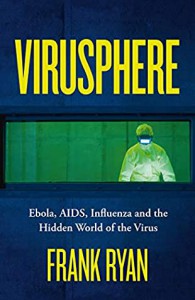
Virusphere by Frank Ryan

TITLE: Virusphere: From common colds to Ebola epidemics – why we need the viruses that plague us
AUTHOR: Frank Ryan
PUBLICATION DATE: 2020
FORMAT: Paperback
ISBN-13: 9780008296704
___________________________
DESCRIPTION:
"A fascinating and long overdue examination of viruses – from what they are and what they do, to the vital role they have played in human history.
What are viruses? Do they rely on genes, like all other forms of life? Do they follow the same patterns of evolution as plants and animals?
Frank Ryan answers these questions and many more in a sweeping tour of illnesses caused by viruses. For example, the common cold, measles, chicken pox, herpes and mumps, rubella, as well as less familiar examples, such as rabies, ‘breakbone’ fever, haemorrhagic fevers like Ebola, and virus-induced cancers. Along the way, readers will learn about the behaviours and ultimate goals of viruses, gaining a deeper understanding of their importance in relation to the origins and the evolution of life, as well as they ways viruses have changed us at the most intimate level, to help make us quintessentially human."
_______________________________
REVIEW:
Rating: Not quite 4 stars but more than 3.5 stars
Virusphere is an introductory text to viruses - the diseases they cause and how they cause these diseases, their evolution, how they "live", how they influence the evolution of other species by messing around with other genomes, and how viruses form part of the Earth's ecosystem. This book starts off by providing a broad survey of a variety of the more common viral diseases ( e.g. measles, flu, cancer viruses etc), as well as the ones generally covered in other disease books such as insect-borne viruses, small pox and HIV/AIDS. I found the second half of the book more interesting as it covers giant viruses (mimiviruses), viral abundance everywhere including Antarctica, how viruses prey on bacteria, virus-wasp symbiosis, and how viruses alter the genomes of other species and influence that species evolution (e.g. retroviral genes in mammal genomes make it possible for placentas to develop properly - no virus, no mammals!). The chapter on the various hypotheses of viral evolution was also particularly interesting.
This is an interesting, informative and short overview of nearly everything virus, written in an engaging and intelligible manner.
 4
4



